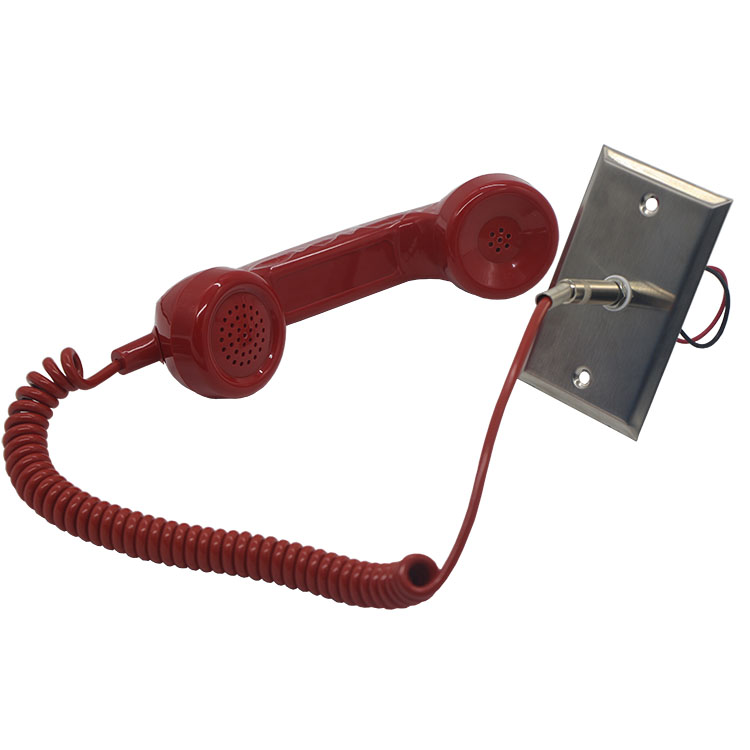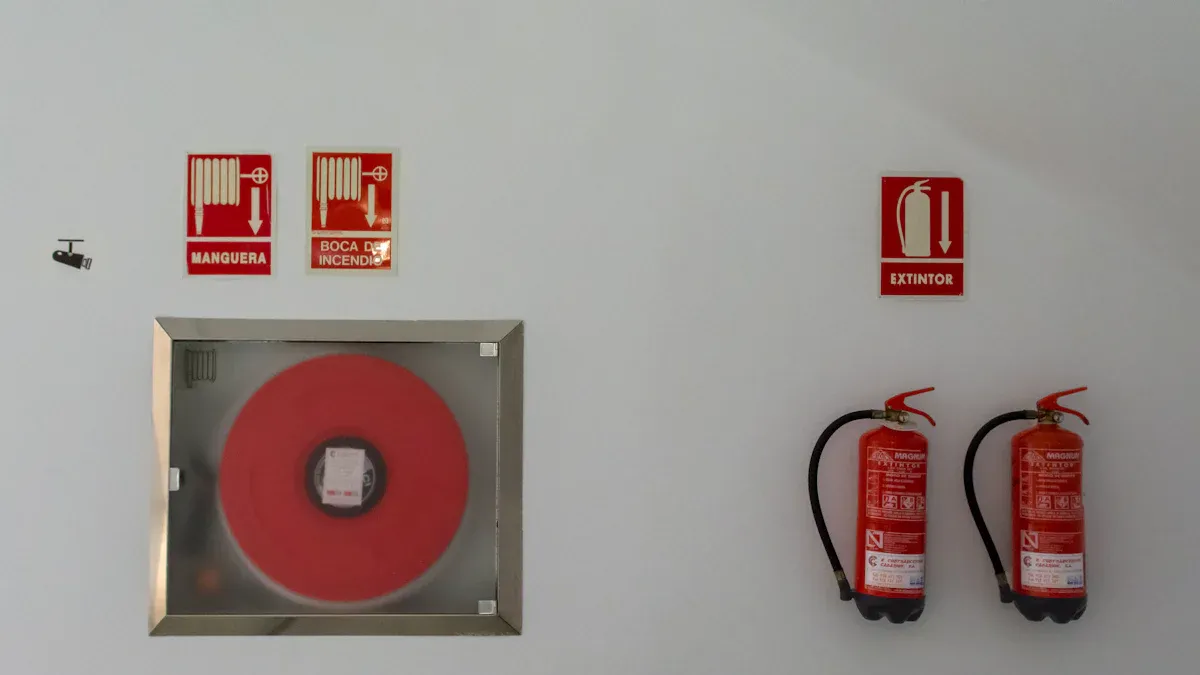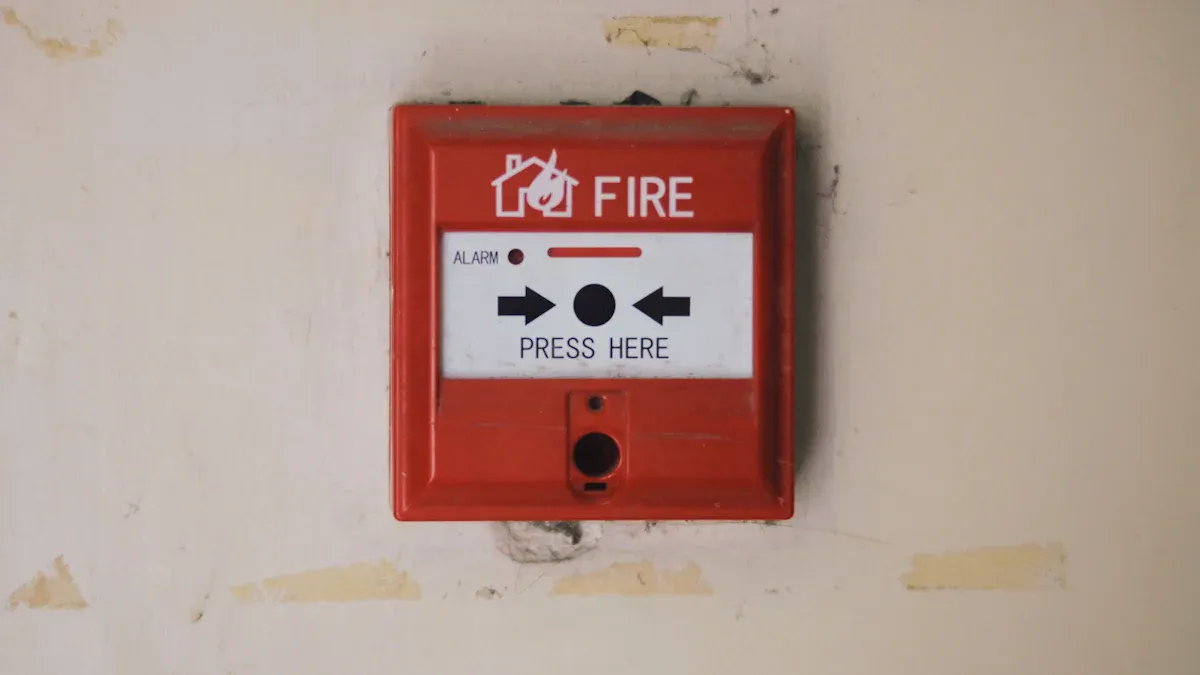
Mit Feuerwehrmeldungen können Feuerwehrleute in Notfällen eine direkte Kommunikation mit Gebäudesteuerungssystemen erstellen. Diese Geräte sorgen für einen zuverlässigen Kontakt, wenn Funksignale ausfallen. Ihr Design integriert sich nahtlos in Notfallsysteme und unterstützt die schnelle Reaktion. Mit einem Feuerwehrmann -Telefon -Handy können Feuerwehrleute effektiv koordinieren und in kritischen Situationen die Sicherheits- und Betriebseffizienz verbessern.
Key Takeaways
- Feuerwehrtelefon -Jäger helfen Feuerwehrleuten bei Notfällen. Sie funktionieren auch, wenn andere Systeme nicht mehr funktionieren.
- Diese Jacks befinden sich in Treppenhäusern, Aufzugsbereichen und Feuerwehrleuten. Dies erleichtert Feuerwehrleuten, sie schnell zu verwenden.
- Der Feuerwehrmann ist stark und hat einen klaren Klang. Es hilft Feuerwehrleuten, in schwierigen Zeiten zu planen und Entscheidungen zu treffen.
Funktionalität von Feuerwehrmeldungen

Wie Feuerwehrmeldungen arbeiten
Fireman Telefonbuchsen fungieren als dediziertes Kommunikationssystem für Notfallszenarien. Im Gegensatz zu Standard-Kommunikationswerkzeugen werden diese Buchsen als eigenständiges, einfaches altes Telefonsystem (TOT) wirken. Dies stellt sicher, dass Feuerwehrleute die Kommunikation aufrechterhalten können, auch wenn Funksysteme ausfallen. Das System stützt sich auf eine einfache Zwei-Draht-Verbindung zum Kommandozentrum, die in kritischen Situationen einen direkten und zuverlässigen Zusammenhang bietet.
Um die Zuverlässigkeit zu verbessern, umfasst das System die Überwachung für Verdrahtungsfehler. Diese Funktion ermöglicht die sofortige Erkennung von Problemen und stellt sicher, dass die Kommunikationslinie in Betrieb bleibt, wenn sie am meisten benötigt wird. Feuerwehrleute verbinden ein Feuerwehrmann -Telefon -Handy mit der Buchse, wodurch sofortige Kommunikation mit Gebäudesteuerungssystemen oder anderem Notfallpersonal ermöglicht wird. Dieser unkomplizierte und dennoch robuste Mechanismus macht Feuerwehrmann -Telefonbuchsen zu einem unverzichtbaren Werkzeug für die Notfallreaktion.
Integration in den Bau von Kommunikationssystemen
Feuerwehrmeldungen werden nahtlos in die Kommunikationsinfrastruktur eines Gebäudes integriert. Diese Geräte werden strategisch an wichtigen Orten wie Treppenhäusern, Aufzugslobbys und Brandschutzräumen platziert, um die Zugänglichkeit in Notfällen zu gewährleisten. Ihre Integration ermöglicht es Feuerwehrleuten, eine direkte Kommunikation mit dem Kommandozentrum des Gebäudes zu erstellen und potenzielle Störungen in anderen Kommunikationskanälen zu umgehen.
Das Design des Systems gewährleistet die Kompatibilität mit vorhandenen Kommunikationsnetzwerken für Gebäude. Beispielsweise verbinden sich die Jacks mit zentralisierten Panels, die Anrufe zum entsprechenden Ziel übertragen, z. B. die Feuerkommandozentrale. Diese Integration vereinfacht nicht nur die Kommunikation, sondern verbessert auch die Koordination zwischen Rettungskräften. Durch die Überbrückung der Lücke zwischen Personal vor Ort und Kommandozentren spielen Feuerwehrmeldungen eine entscheidende Rolle bei der effektiven Verwaltung von Notfallsituationen.
Technische Aspekte von Feuerwehrmeldungen
Kabel- und Netzwerkkomponenten
Feuerwehrmeldungen verlassen sich auf ein robustes Kabel- und Netzwerksystem, um eine ununterbrochene Kommunikation während der Notfälle zu gewährleisten. Diese Systeme verwenden in der Regel eine Zwei-Draht-Verbindung, die die Installation vereinfacht und die Zuverlässigkeit verbessert. Die Verkabelung verbindet die Buchsen mit einem zentralisierten Bedienfeld und ermöglicht eine nahtlose Kommunikation zwischen Feuerwehrleuten und dem Kommandozentrum.
Moderne Systeme wie das SK-FFT Firefighter-Telefonkommunikationssystem enthalten erweiterte Funktionen, um die Funktionalität zu verbessern. Zum Beispiel:
- Ein Tastatur zeigt Telefonaktivierung und Problembedingungen an und stellt eine schnelle Identifizierung von Problemen sicher.
- Das System unterstützt bis zu 48 Remote -Feuerwehrhörungen und bietet eine umfassende Abdeckung in großen Gebäuden.
- Bis zu 10 Feuerwehrmobilteile können gleichzeitig über denselben Stromkreis kommunizieren und eine effiziente Koordination ermöglichen.
- Zusätzliche Funktionen wie JumpStart ™ Auto -Programmierung und ein Formular C Trouble Relay, vereinfachen das Setup und verbessern die Systemzuverlässigkeit.
Diese technischen Komponenten stellen sicher, dass Fireman -Telefonbuchsen auch unter herausfordernden Bedingungen in Betrieb bleiben und sie zu einem kritischen Bestandteil der Notfallkommunikationssysteme machen.
Installationsstandorte in Gebäuden
Die strategische Platzierung von Feuerwehrmeldungen in Gebäuden maximiert ihre Zugänglichkeit und Effektivität. Diese Buchsen sind üblicherweise in Bereichen installiert, in denen Feuerwehrleute in Notfällen wahrscheinlich operieren. Zu den wichtigsten Standorten gehören Treppenhäuser, Aufzugslobbys und Feuerwehrläden. Durch das Platzieren von Buchsen in diese Bereiche wird sichergestellt, dass Feuerwehrleute schnell Kommunikation herstellen können, ohne wertvolle Zeit zu verschwenden.
In Hochhäusern werden häufig auf jeder Etage zusätzliche Buchsen installiert, um eine umfassende Abdeckung zu erzielen. Diese Platzierungsstrategie stellt sicher, dass Feuerwehrleute unabhängig von ihrem Standort innerhalb des Gebäudes die Kommunikation aufrechterhalten können. Durch die Priorisierung der Zugänglichkeit und der strategischen Positionierung verbessern die Baudesigner die allgemeine Sicherheit und Effizienz der Notfallreaktionsbemühungen.
Bedeutung in Notszenarien

Rolle in der Feuerwehrkommunikation
Feuerwehrmeldungen spielen eine entscheidende Rolle bei der Gewährleistung nahtloser Kommunikation in Notfällen. Diese Geräte bieten Feuerwehrleuten eine zuverlässige Methode, um kritische Informationen auszutauschen, wenn andere Systeme wie Radios aufgrund von Störungen oder technischen Problemen fehlschlagen. Durch die Verbindung eines Feuerwehrmann -Telefons mit der Buchse stellen Feuerwehrleute einen direkten Sprachkontakt mit Kommandozentren oder anderen Notfallpersonal her. Diese sofortige Kommunikation ermöglicht eine schnelle Entscheidungsfindung und Koordination, die für die effektive Verwaltung von Situationen mit hohem Stress von entscheidender Bedeutung sind.
Das Feuerwehrmann -Handy -Mobilteil ist speziell so konzipiert, dass ein klares Audio -Getriebe geliefert wird und Hintergrundgeräusche minimiert, die die Kommunikation behindern könnten. Das kompakte und tragbare Design ermöglicht es Feuerwehrleuten, es schnell einzusetzen, um eine ununterbrochene Kommunikation bei Brandvorfällen zu gewährleisten. Diese Merkmale machen das Mobilteil unverzichtbar für die Aufrechterhaltung der betrieblichen Effizienz und Sicherheit in Notfällen.
Beispiele für den Gebrauch, einschließlich Aufzugsanschlüsse
Feuerwehrmeldungen werden strategisch in Gebäuden platziert, um Notfallvorgänge zu unterstützen. Ein bemerkenswertes Beispiel ist die Verwendung in Aufzugssystemen. Während eines Brandes werden Aufzüge oft für die öffentliche Verwendung unsicher, bleiben aber für Feuerwehrleute von entscheidender Bedeutung. Feuerwehrmeldungen, die in Aufzugslobbys und in Aufzugsautos installiert sind, ermöglichen es Feuerwehrleuten, direkt mit der Kommandozentrale zu kommunizieren. Dies stellt sicher, dass Aufzugsbewegungen sicher und effizient koordiniert werden können, was Rettungsbemühungen und Brandunterdrückungsaktivitäten erleichtert.
Zusätzlich zu Aufzügen sind diese Buchsen üblicherweise in Treppenhäusern, Feuerlöschräumen und hohen Gefangenen in Gebäuden zu finden. Ihre Platzierung stellt sicher, dass Feuerwehrleute unabhängig von ihrem Standort auf Kommunikationspunkte zugreifen können. Hochhäuser, Krankenhäuser und Industrieanlagen bieten häufig umfangreiche Netzwerke von Feuerwehrhörungen, um eine umfassende Abdeckung zu erzielen. Diese strategische Integration verbessert die Gesamtwirksamkeit von Notfallverantwortungssystemen.
Feuerwehrmann und seine Rolle
Das Feuerwehrmann ist ein kritischer Bestandteil von Notfallkommunikationssystemen. Das Mobilteil wurde für Langlebigkeit und Zuverlässigkeit entwickelt und ist mit robusten Materialien gebaut, um heftigen Umgebungen standzuhalten. Sein ergonomisches Design sorgt selbst in Situationen mit hoher Stress. Feuerwehrleute verlassen sich auf dieses Gerät, um eine klare, wechselseitige Kommunikation mit verstärkten Lautsprechern und hochwertigen Mikrofonen aufrechtzuerhalten, die die Verzerrung minimieren.
Das Mobilteil integriert nahtlos in das Telefonsystem der Brandfeuerfeuer, wobei die Kompatibilität mit Feueralarmsteuerungsträgern bietet. Diese Integration ermöglicht es Feuerwehrleuten, sich direkt mit dem Aufbau von Kommunikationsnetzwerken zu verbinden, um einen ununterbrochenen Kontakt während der Notfälle zu gewährleisten. Die einfache Oberfläche des Mobilteils mit klar beschrifteten Schaltflächen ermöglicht den schnellen Zugriff auf wichtige Funktionen.
| Besonderheit | Beschreibung |
|---|---|
| Zuverlässige Leistung | Für ein klares Audiogetriebe entwickelt, wobei Hintergrundgeräusche minimiert werden. |
| Robuste Konstruktion | Gebaut mit dauerhaften Materialien, um harte Umgebungen standzuhalten. |
| Einfach zu bedienende Schnittstelle | Verfügt über eine einfache Schnittstelle mit klar beschrifteten Schaltflächen für den schnellen Zugriff. |
| Kompatibilität | Integriert sich in die direkten Kommunikation mit Notifier -Feueralarmsteuerungsträgern. |
| Vielseitige Anwendungen | Ideal für Hochhäuser, Industrieanlagen und gewerbliche Immobilien. |
Feuerwehrmeldesysteme, einschließlich des Mobilteils, sorgen für eine zuverlässige Kommunikation in Notfällen. Sie bieten den Feuerwehrleuten die Tools zur Verfügung, um wichtige Informationen auszutauschen, Rettungsbemühungen zu koordinieren und Krisen effektiv zu verwalten.
Feuerwehrmeldungen dienen als wesentliche Werkzeuge für die Notfallkommunikation. Ihre strategische Platzierung in Gebäuden gewährleistet die Zugänglichkeit während der Krisen. Diese Geräte verbessern die Sicherheit, indem sie zuverlässige Kommunikation bereitstellen, wenn andere Systeme ausfallen.
Feuerwehrmeldungen integrieren sich nahtlos in moderne Notfallsysteme, sodass Feuerwehrleute effektiv koordinieren und auf Notfälle mit Präzision reagieren können.
FAQ
Was ist der Hauptzweck eines Feuerwehrmanns?
Feuerwehrmeldungen bieten Feuerwehrleuten eine dedizierte Kommunikationsverbindung an, um sich mit Befehlszentren während der Notfälle zu koordinieren, um zuverlässiger Kontakt zu gewährleisten, wenn andere Systeme ausfallen.
Wo werden Feuerwehrmeldungen normalerweise installiert?
Diese Buchsen sind in Treppenhäusern, Aufzugslobbys, Feuerwehrleuten und hohen Verkehrsräumen installiert, um die Zugänglichkeit für Feuerwehrleute in Notfällen zu gewährleisten.
Kann Fireman Telefonbuchsen ohne externe Leistung funktionieren?
Ja, die meisten Systeme arbeiten unabhängig eine Zwei-Draht-Verbindung, um die Funktionalität auch bei Stromausfällen oder Systemfehlern sicherzustellen.

